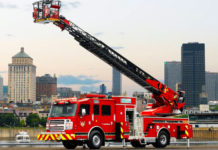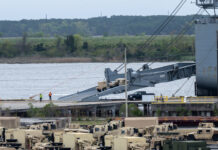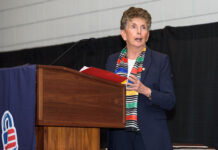By the New York Times
A wintry pummeling of snow, bitter cold and strong winds was battering the East Coast on Thursday as a powerful storm system that dumped ice, sleet and snow on the South curled toward the Northeast.
Snow plows and salt trucks are rumbling down streets, schools and offices are closed, thousands of flights have been canceled and homeless shelters are crammed as the storm, which some meteorologists classified as a “bomb cyclone” for its sharp drop in atmospheric pressure, has paralyzed much of the East.
Many governors or local leaders have declared emergencies, and blizzard warnings were in effect in Delaware, Maine, Maryland, Massachusetts, New Jersey, Rhode Island and Virginia.
The National Weather Service said Atlantic City, N.J., could record up to 18 inches of snow, and Delaware beach towns were facing the prospect of a foot of snow.
(Fox News’ Laura Ingle on the preparations for the major winter storm moving up the Northeast coast. Courtesy of Fox Business and YouTube. Posted on Jan 4, 2018)
Here’s the latest:
- Most of New York City was forecast to receive five to eight inches of snowfall, although Queens, and neighboring Nassau County, could get up to 10 inches, forecasters said.
- Schools are closed, but the trains are running.
- The storm also shut down schools in Baltimore; Boston; Newark; Philadelphia; Providence, R.I.; Virginia Beach; and Washington, among other places.
- Classes were also canceled in areas in the South that had seen snowfall and anticipated days of bitter cold.
- Some districts in Georgia, North Carolina and South Carolina closed schools for Thursday.
The storm’s race up the East Coast — through some of the busiest air traffic corridors in the country — prompted airlines to cancel nearly 3,000 flights by early Thursday morning, according to FlightAware, an aviation tracking website.
Nationwide, airlines have already scratched plans for more than 150 flights on Friday.
- Tens of thousands of customers, mostly in Virginia, were without power on Thursday morning, and even in places where electricity was mostly flowing, officials feared the consequences of frigid temperatures that will linger for days.
- With heating units in homes and commercial buildings running furiously to fend off the deep freeze, power companies have warned of possible fuel shortages to come.
Northeastern states are facing a major blow.
The Weather Service has issued a winter storm warning for parts of New York, New Jersey and Connecticut, with heavy snowfall and wind chills as low as minus 25 degrees expected.
Kathryn Garcia, the commissioner of the Department of Sanitation in New York City, encouraged New Yorkers to avoid driving and use mass transit instead.
Chilly gusts of up to 50 miles per hour are likely to whip eastern Long Island and southeastern Connecticut starting late Thursday morning, with the potential for downed tree limbs and scattered power failures, the National Weather Service said.
With thousands of flights canceled, American Airlines, Delta Air Lines, JetBlue, Southwest and United were among the major carriers that said passengers could change certain travel plans without penalties.
In the Washington area, the federal government delayed opening offices on Thursday morning as slush and slick roads subsumed the capital.
The Office of Personnel Management, essentially the federal government’s human resources department, said that nonemergency workers could report two hours late, work remotely, or take an unscheduled leave.
The National Weather Service predicted a Thursday high of 28 degrees for Washington, with winds gusting to 40 m.p.h. Temperatures are not expected to reach the 40s — maybe — until Monday.
(Millions of people are dealing with dangerous wind, ice and snow. The brunt of the storm will hit Massachusetts Thursday afternoon. Parts of Boston could see more than a foot of snow. Courtesy of CBS This Morning. Posted on Jan 4, 2018)
In Boston, ‘It’s going to look pretty rough out there.’
Lightly blowing snow began early Thursday morning in Boston, where the predicted snowfall totals had edged upward, with 10 to 16 inches of snow forecast during the day, with another 1 to 3 inches possible in the evening.
Schools were closed up and down the coast, including in Providence, R.I., Portsmouth, N.H., Portland, Me., and beyond.
Gov. Charlie Baker of Massachusetts said the storm was expected to worsen in Boston by midday, potentially bringing coastal flooding, high winds and rapidly falling snow.
“Anybody who watched any of the national news programs last night saw the power that this thing had coming up the coast,” Mr. Baker said, as he urged people to stay off the roads if possible.
“You don’t hear the weather people use the term blizzard or whiteout very often.”
“In a few hours, across most of Central and Eastern Mass., it’s going to look pretty rough out there,” Mr. Baker said.
The storm will follow a long period of deep cold that has already taxed transit systems, fuel supplies and homeless shelters in the region.
(Bomb cyclones have been referred to as “winter hurricanes.” NYT science reporter explains how they really work. Courtesy of the New York Times and YouTube. Posted on Jan 3, 2018)
What exactly is a ‘bomb cyclone’?
When discussing the storm, some weather forecasters have referred to a “bomb cyclone.” Calling it a bomb sounds dire, but such storms are not exceedingly rare — there was one in New England recently.
What makes a storm a bomb is how fast the atmospheric pressure falls; falling atmospheric pressure is a characteristic of all storms.
By definition, the barometric pressure must drop by at least 24 millibars in 24 hours for a storm to be called a bomb cyclone.

Here is how it works:
- Deep drops in barometric pressure occur when a region of warm air meets one of cold air.
- The air starts to move, and the rotation of the Earth creates a cyclonic effect.
- The direction is counterclockwise in the Northern Hemisphere (when viewed from above), leading to winds that come out of the northeast — a nor’easter.
That’s what happened at the end of October, when warm air from the remnants of a tropical cyclone over the Atlantic collided with a cold front coming from the Midwest.
Among other effects then, more than 80,000 customers in Maine lost power as high winds toppled trees.
A similar effect was occurring Wednesday, as warm air over the ocean met extremely cold polar air that had descended over the East.
Pressure was expected to fall quickly from Florida northward.
Why is it so cold? What’s the influence of climate change?
The Times’s Henry Fountain takes a look. Read more here.
(A rare weather event called a “bomb cyclone” is bearing down on millions of people on the U.S. East Coast. It’s part of a larger cold snap that’s put much of North America in a freeze since Christmas. Now, Americans are bracing for the bomb cyclone’s potentially dangerous combination of snow, freezing rain, and hurricane-force winds. Courtesy of The National and YouTube. Posted on Jan 3, 2018)
An Atlanta hospital calls it ‘the most challenging winter.’
The new round of shivering prolonged what has already been a difficult period in emergency rooms across a broad swath of the United States.
In the Atlanta area, where temperatures were hovering around freezing on Wednesday but were expected to plunge into the teens after nightfall, doctors said they had been seeing an unusual number of patients with weather-related emergencies.
“This is the most challenging winter, in terms of exposure, that I’ve ever seen,” said Dr. Brooks Moore, the assistant medical director of the emergency department at Grady Memorial Hospital, Atlanta’s public hospital.
Dr. Moore said that about 20 people were arriving at the emergency room each day with minor complaints related to the weather and that about the same number were appearing with conditions like asthma or emphysema that were exacerbated by the cold.
He added that doctors were seeing about one or two patients a day whose core body temperatures had fallen into the low 80s — normal is about 98.6 degrees — and required “aggressive rewarming” techniques.
Even Florida got a rare dusting as snow fell in the Southeast.
Some states in the Southeast were blanketed with snow, with up to six inches recorded in parts of Georgia and North Carolina and four to seven inches across parts of South Carolina, the National Weather Service said.
Snow even fell on Tallahassee, Florida’s capital. More than 50 miles of Interstate 10 were closed in the Tallahassee area, as well as parts of Highway 90. Mark Wool, a Weather Service meteorologist, said that flurries seemed to come along every few years there. But the snow accumulation Wednesday — about a tenth to two-tenths of an inch — had not been seen since 1989.
















